Recent laws in New Jersey and California represent a disturbing trend that will negatively impact a practice’s ability to collect monies from patients, as well as expose them to significant penalties if the practice does not follow the mandatory guidelines to a T. Please be aware that a similar law may be coming to your state. The time to act is before the law is passed.
The Early College Wars, Part I
The Early College Wars (Based on Chapter 7 in: Keating JC. B.J. of Davenport: The Early Years of Chiropractic. Davenport IA: Association for the History of Chiropractic, 1997).
Many of the schisms and much of the continuing animosity among members of the chiropractic profession are reflections of the struggles among the early chiropractic colleges. And so it may be useful to revisit some of the early sparring among the leaders of the several chiroschools.
Perhaps the earliest example of the feuds among educators was that among the Palmers and rival Solon Langworthy, DC, a 1901 Palmer alumnus who had established the American School of Chiropractic & Nature Cure (ASC&NC) in Cedar Rapids, Iowa by 1903. Langworthy advocated and employed a wide range of "natural" healing methods, including manipulation, traction and dietary recommendations, all of which were considered "not chiropractic" or "mixing" by the parent school in Davenport. Langworthy hired 1899 Palmer graduate Oakley Smith as the dean of the ASC&NC, and yet another graduate of the Davenport institute, Minora Paxson, as chair of the department of obstetrics and gynecology. The trio of Smith, Langworthy and Paxson are remembered as authors of the first textbook of chiropractic, Modernized Chiropractic, which they published in 1906 (Gibbons, 1981).
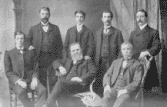
Standing, left to right: E.E. Sutton (1901), BJ (1902), O.B. Jones (1900), Solon M. Langworthy (1901); seated, left to right: Oakley G. Smith (1899), Old Dad Chiro, Thomas H. Storey (1901); this photograph first appeared in the February, 1905 issue of The Chiropractor.
The father of chiropractic directed much animosity toward Langworthy and his competing institution. When Langworthy collaborated with Daniel Reisland, DC, of Duluth to establish licensing legislation for chiropractors in Minnesota, the Palmers visited the governor to urge his veto of the statute, which would have permitted licensure of Langworthy's graduates, but not the alumni of the Palmer School (Gibbons, 1993). The pages of The Chiropractor, published by the Palmer School, filled with invectives against Old Dad Chiro's former pupil.

Minnesota Governor John Johnson.
Like his father, B.J. Palmer, DC, who took over the reins of the Palmer School in 1906, construed himself as an "adjustor" of the supposedly erroneous ideas he encountered in much of the chiropractic literature. B.J. was a passionate proponent of "pure, straight and unadulterated" chiropractic. Anything else was mixing, and suggested a subluxation in the spine of any chiropractor who descended to such depths. He named the condition:
Chiropractoiditis: a disease, feeling of unrest of the brain, that those who think themselves chiropractors, suffer with. Its breeding or culture ground is often the school from which he comes. Its incipient symptom is very often an itching in the palm.
The Major for chiropractoiditis is always found at The P.S.C.
The adjustment consists of a (P.S.C.) P.G. course. It usually takes the case about four months to recover (Palmer, 1916).
The cause of this mixing disease, B.J. offered, was the the flawed teaching and lack of true chiropractic principles of other schools. The Palmer School of Chiropractic (PSC), as the "mother school" of the profession, was the one sure source of truth in matters of health and illness. B.J. would save chiropractic, not only from their common medical foe, but from chiropractors themselves.

B.J. Palmer, circa 1920.
All other chiropractic writers, periodicals and institutions, it seemed, came up for review, sooner or later, in the pages of B.J.'s weekly Fountain Head News. And though school leaders, each competing with every other for precious students, sometimes clashed with one another, for the most part the war among the chiropractic colleges was a tale of the PSC against the world. Palmer always insisted upon the Fountain Head's distinct position among chiropractic institutions:
The Palmer School of Chiropractic has NO Branch Schools
The Sunday Call (Newark, N.J.) of January 30, 1921, contained an article about the new home just purchased, of The Eastern College of Chiropractic. In this article it said:
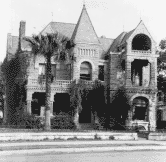
Campus of the Texas Chiropractic College in San Antonio, circa 1920.
"The Eastern College of Chiropractic, a branch of the original palmer school, was organized in January, 1918."Be it said to the credit of Dr. Kightlinger, this is a newspaper error; nevertheless it cannot go unrefuted.
The Missouri Chiropractic College has been frequently quoted as being "a branch school of the Palmer school." From all reports that I get and from the correspondence reaching me, I am told that nothing is directly said which substantiates that, but innuendoes and inferences are made which lead people to think that.
The Missouri Chiropractic College is not a branch of the Palmer School.
The Texas Chiropractic College advertises to use "Palmer Methods" and "Palmer Textbooks", both of which may or may NOT be true. They maintain they do. Reports from outsiders are to the contrary. That matters not here. The one point to be made at THIS time is that The texas chiropractic college is not a branch school of the palmer school.
Other schools over the country have found it profitable to use REAL Chiropractic - which is the kind The Palmer School of Chiropractic has been teaching since 1895. They have found it to their advantage to profit from our national publicity and advertising campaigns on straight Chiropractic. They know the reputation we have made; they propose to build upon the same basis. Their ambition is laudable; their methods noble, providing in the doing of the same they do not mislead the purchaser to think they are a branch school.
The Palmer School of Chiropractic has no branch schools, nowhere, no-time. If we ever get ready to go into the Branch School idea, we'll let the profession know squarely from us direct, first.
The Palmer School of Chiropractic, nor no person connected with it from BJ down, have one dollar invested in any other school no matter where it is located, no matter who states to you to the contrary. We hope that all chiropractors will spread this information.There is only one Palmer School - Davenport, Iowa. There can be but one "Palmer School" - Davenport, Iowa. Because there is only one "B.J. Palmer" - Davenport, Iowa (Palmer, 1921).

Alva Gregory, MD, DC, circa 1912.
In the early years of B.J.'s reign, Alva Gregory, MD, DC came in for special attention. His Palmer-Gregory College of Chiropractic in Oklahoma City was a sore point to the Developer in several respects. Firstly, it carried a name that threatened B.J.'s preeminence and uniqueness among schools. Secondly, Gregory had created a rival national society of chiropractors in 1911, with headquarters at his Oklahoma school. Lastly, Gregory epitomized the "medicalization" of chiropractic. He recommended his form of spinal treatment, termed spondylotherapy, as a supplement to general medical procedures (Gregory, 1912).
Spondylotherapy involved manual and mechanical concussion of the spine, as well as traction, massage and therapeutic heat, all of which were anathema to the Developer. The Palmer-Gregory College merged temporarily with the St. Louis College of Chiropractic (SLCC) during 1913-1914 (Consolidation, 1913). The SLCC was operated by L. William Ray, A.M., MD, DC, and offered "partial correspondence" courses, in the mode established by the Palmer and National Schools. But this amalgamation was short-lived, and Gregory gradually faded from the chiropractic scene. For years to come, however, his textbooks continued to encourage what B.J. abhorred as "medipractic."

Joy M. Loban,DC.
Joy M. Loban, DC, former chairman of the department of philosophy at the PSC, added a new dimension to the struggle among the schools in 1913. Loban was one of the organizers of the Universal Chiropractic College in 1910, a school formed in apparent reaction to B.J.'s curriculum. When D.D. Palmer died in 1913, Loban repeatedly sought grand jury indictments of the "Developer" for homicide, claiming that B.J. had struck the founder with his automobile during a parade in Davenport in August, 1913. No charges were ever brought, but the continuing accusations of patricide fouled the chiropractic literature for decades to come.
Table 1: Chartered institutions comprising Frederick W. Collins' First National University of Naturopathy & Allied Sciences
- New Jersey College of Chiropractic & Naturopathy (1910-1916)
- "The Famous Mecca College of Chiropractic, the Shrine of Chiropractic" (1916-1943)
- American School of Naturopathy
- United States School of Naturopathy American School of Iridiology
- New Jersey School of Osteopathy National School of Neuropathy
- Union School of Physical Culture & Gymnastics
- Modern School of Electrotherapeutics
- Newark School of Arts & Applied Psychology-Registered
- American Academy of Medicine, Inc.
- White Cross School of First Aid
- American College of Spectro-Chrome Therapy Inc.
- American College of Electronic Reactions & Radio Activity Inc.
- Naturopathic Health School of Chicago
- First National University of Naturopathy
Another school leader who received harsh rebuke from B.J. was Frederick W. Collins,MD,DO,DC, PhC. B.J. minced no words, calling the Newark, New Jersey founder of the Mecca College of Chiropractic a "fraud," "mountebank" (Gibbons, 1989) and "crooked," and likening him to Joy Loban, DC, for lack of scruples (Palmer, 1919a). Collins responded by labeling Palmer "the biggest faker in the world (Gibbons, 1989). His brand of drugless healing bespoke what B.J. considered a lack of commitment to the true chiropractic cause. He practiced as an osteopath in New Jersey and as a chiropractor in New York. Collins' doctoral degrees were as questionable as the many "schools" he operated, all under one roof (see Table 1 above ). Perhaps what most vexed the Davenport leader was Collins' claim to have graduated from a 12-month course and to have earned a "DC" from the Palmer School on January 3, 1912. B.J. issued this challenge:
I will give Dr. Collins or any other person of equal calibre, the sum of $5,000 or any multiple thereof, to prove to any jury anywhere that he ever spent ONE month at THE PALMER SCHOOL of Chiropractic; or that he ever enrolled here for any course of Residential work.
Collins' most famous graduate, pharmacist-chiropractor Craig M. Kightlinger, MA, DC, was apparently not satisfied with his training at the broad-scope Newark school. After opening the competing Eastern College of Chiropractic in Newark circa 1918, Kightlinger enrolled for postgraduate training at the PSC (Keating, 1996). No less a straight chiropractor than the Developer, he wandered in and out of B.J.'s camp for the next three decades. Kightlinger seemed to confirm Palmer's impression of Collins when he wrote to B.J. to strenuously object to misrepresentations Collins had made:
I am so mad, real sure enough hot under the collar mad. Just received Collins' latest explosion and he has my name in it AND FOUR OF THE OTHER STRAIGHT BOYS. What he says is one down right lie and I am getting the others together tonight to make some means of making him stop this publication. I never said that he was a great adjuster and if I ever hope to be like him, I would desire my friends to have me adjudged insane. I always considered him a very poor adjuster and I do so today...If you can suggest some method by which we can effectively put a stop to all these lies and cheap trash, I wish you would give me the aid of your advice. What Collins says, as quoting me, is a lie... (Kightlinger, 1919).
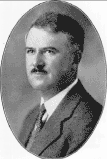
Craig M. Kightlinger,MA,DC, circa 1924.
Table 2: Founding members of the Associated Colleges & Schools of Chiropractic, 1917.
- NJ College of Chiropractic amalgamated with the Mecca College of Chiropractic, Newark
- New England College of Chiropractic amalgamated with the Washington School of Chiropractic, Washington, D.C.
- St. Paul College of Chiropractic, Minnesota
- Palmer-Gregory College of Chiropractic, Oklahoma City
- Empire College of Chiropractic, New York
- New York School of Chiropractic, New York
- Davenport School of Chiropractic, Iowa
The animosity between Palmer and Collins was amplified in 1917 when, shortly after the formation of the International Association of Chiropractic Schools & Colleges (IACSC) during the Palmer lyceum, Collins announced his own Associated Colleges & Schools of Chiropractic (ACSC) (Fountain, 1917), comprised of institutions lying outside B.J.'s acknowledged sphere of influence (see Table 2 above). Palmer pointed out that the ACSC had been falsely listing the Carver Chiropractic College and the Universal Chiropractic College as ACSC members, when in fact these two institutions were founding members of the IACSC. Collins' partner at the Mecca College, Francis W. Allen, D.C., likened B.J. to the German Kaiser. Their vitriolic exchange was all for naught, and neither association was able to achieve its supposed primary purpose: to standardize chiropractic education.
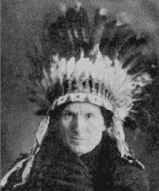
"Big Chief Sayeth," cover of the Scientific Head News 1917, Number 1, published at "Intellectual Hilltop" by the Carver Chiropractic College, Oklahoma City; this photo is an uncharacteristically campy presentation of the usually dignified attorney-chiropractor.
There were other favorite targets who repeatedly earned B.J.'s scorn. Very little that attorney-chiropractor Willard Carver said or did ever earned a word of praise from the "Developer," and Carver always responded in kind (Jackson, 1994). Carver's ego approached B.J.'s in magnitude; he designated himself the "Constructor of Chiropractic" and published the Scientific Head News, as though to mimic Palmer. Their mean-spirited feud, played out in their respective college periodicals, often dealt with trivial matters, such as who was the longest-time chiropractic student, or which was the first chiropractic school to be incorporated (Carver, 1919), or who was the true "defender" of chiropractic. Even when they were in agreement on some issue, they often contended over who had adopted such and such a position first (Carver, 1919). They mocked one another. Palmer's animosity toward the "Constructor of Chiropractic" was apparent in a 1919 letter (Palmer, 1919b) to William C. Schulze, MD, DC, president of the National School of Chiropractic in Chicago.
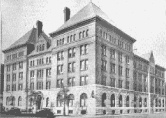
Campus of the National College of Chiropractic at 20 N. Ashland Blvd., Chicago, 1920.
B.J. publicly withdrew his acceptance of Schulze's invitation to speak at National's homecoming because Carver was also on the program:
In getting your Lyceum Program, ten days ago, I noticed Willard Carver on, he being on the same afternoon as I. I will not be on your program as scheduled. Had I known that Willard Carver was on your program at all, I should never have accepted your invitation.My two reasons are:
Willard Carver has been, is and will continue deliberately misrepresenting me, in ways now so apparent to the Chiropractic profession that he has lost their friendship, confidence and business.
Willard Carver intentionally preaches "Chiropractic" and deliberately reaches Orificial Surgery, and has in many ways, knowingly, diverted his ideas from the fundamental principles of Chiropractic laid down by my father in 1895.
Both of these are injurious to the present or future welfare of Chiropractic; that being true I cannot have my name connected, or affiliated with any meeting which might give credence, or value to him or his ideas, which would tend to destroy real Chiropractic.
It is for these same reasons Willard Carver has been refused time and again, even upon his personal solicitation, a place on any of our Lyceum Programs. We have no difficulty in getting good, constructive, clean Chiropractic professional material without him.
Feeling this, as I do, it is time for me to ease MY conscience and withdraw from being placed on any program with him, when I wouldn't invite such as he to be on OUR program. If, in my opinion, his presence here would be destructive to Chiropractic, then my opinion of him and his work does not change when you shift the location to Chicago. I would not sit on a program with him here; why should I do so in Chicago?
"To thine own self be true." I can get away from everybody but myself. I can keep MY heart clean and MY conscience clear. To invite Carver here would be to publicly acknowledge him and his ideas of me, and his ideas of Orificial Surgery. My presence on your program, to a more limited extent, would also acknowledge what he HAS said is true, and what he IS TO SAY is Chiropractic, both of which are UNTRUE. I cannot acknowledge such - for the sake of Chiropractic. If you can afford to assume such a risk, then that is your judgment...
I wanted to let you know as soon as I had settled the matter with myself, that you might fill your program with somebody else. I shall also print this letter in the F.H.N., so that no one will misunderstand my reason for NOT being present, and so they will know exactly WHY I AM NOT.
I wish your Lyceum every success in the world. I hope the numbers are great and the attendance large. I hope the Chiropractic end is strong enuf to overcome the insidious Orificial Surgery mixing theory which you have permitted to lie close to your bosom. You deserve success and I hope you get it.
P.S. - Watch out for prospective students hanging around. Willard is a past master at trying to steal business. We won't have any barnacles hanging around here, by invitation, we can't trust.



